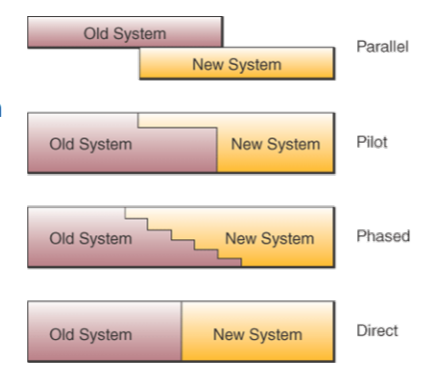The implementation phase, during which the system is actually built. After the implementation phase, the new system and maintenance plan is produced.
System construction
The system is built and tested to ensure it performs as designed. Because the cost of bugs can be immense, testing is one of the most critical steps in the implementation.
System installation
Installation is the process by which the old system is turned off and new system is turned on. There are four main system installation approaches that organisations can choose from:

- Direct cut-over
- It is an approach where the old system is completely shut down and the new system is immediately switched on.
- Pro: Quick transition, minimal disruption after the switch, saves resources by not needing to run both systems simultaneously.
- Con: High risk of failure, potential for data loss during transition, puts pressures on users and IT staff to adapt quickly.
- Parallel running
- Both the old and new systems run concurrently for a period of time. Users can test and become familiar with the new system while the old system remains as a backup.
- Pro: Allows major problem to be encountered and corrected without the loss of data; users have time to familiar with the new system before full switch-over.
- Con: More resource-intensive (requires maintaining both systems)
- Phased installation
- The new system is implemented in stages, It involves the new system to be gradually introduced whilst the old system is progressively discarded or removed. It is suitable when the new system is still under development.
- Pro: Allows user feedback and adjustments on each phase, minimise disruption to overall operations.
- Con: Takes longer to fully implement the system, requires careful planning and coordination for each phase.
- Pilot installation
- The new system is deployed to a limited group of users or single department before a wider rollout. The pilot users will evaluate the new system, once the new system is deemed to be performing satisfactorily it can then be installed and used by all. These pilot users can assist other new users when the system is fully installed.
- Pro: Low risk, provide valuable user feedback to improvement before broader implementation.
- Con May not fully capture the complexities of a full-scale development.
Back to parent page: Software Development Life Cycle (SDLC)